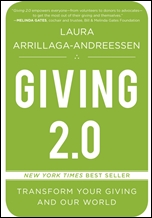Posted by Eileen Ellsworth
This is the fifth post in a series reviewing the book “Giving 2.0” by Laura Arrillaga-Andreessen (Great Giving LLC, 2012)
No book on “Giving 2.0” would be complete without discussing social entrepreneurship – start-up businesses that seek to develop social – not financial – gains. Since the 1990’s, social entrepreneurship has repeatedly proven the concept that market based models of corporate development can be used to solve complex social issues as well.
The author of Giving 2.0, Laura Arrillaga-Andreessen, lays out the features of social entrepreneurship that distinguish it from both nonprofit and for-profit business ventures:
- “Cross-subsidization”, or the idea that social entrepreneurs charge their service recipients who can afford it.
- Sustainable business models that work on big social problems for a very long time instead of gunning for the “exit strategy”.
- Identification of and investment in the individual social entrepreneurs themselves rather than the business model.
- Treating service recipients as self-determinative customers and not victims.
- A readiness to share ideas with other social entrepreneurs for the betterment of society.
A number of successful intermediaries who pool donated dollars for social entrepreneurship investing have developed over the years, such as the Acumen Fund in New York, Ashoka in Alexandria, Virginia, and TechnoServe in Washington DC. These intermediaries have also pioneered the idea of “citizen philanthropy” in which anyone can nominate, fund and mentor a social entrepreneur.
Market-based models of philanthropy are thriving, proliferating, and making a difference across the globe.

